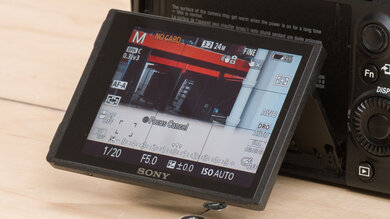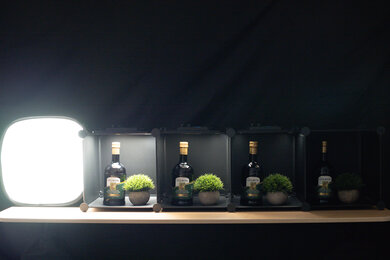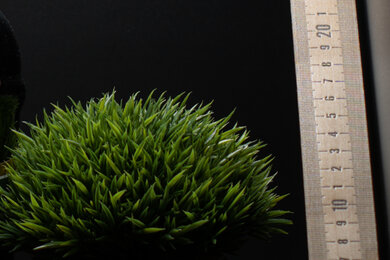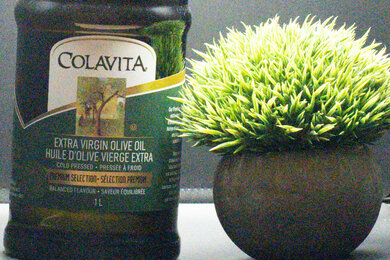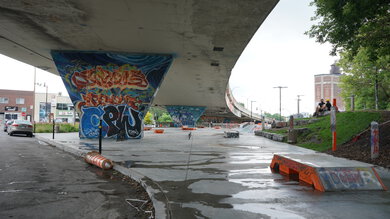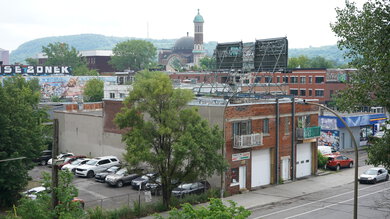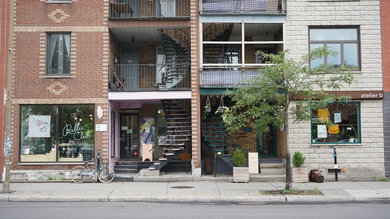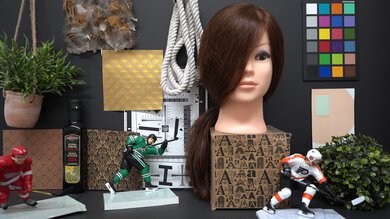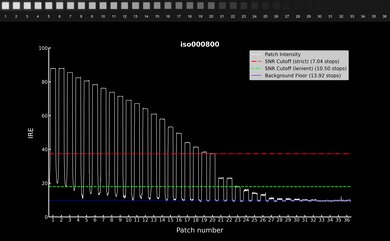The Sony α7 III is a full-frame mirrorless camera first released in 2018. It's the third iteration of the "base" full-frame model in Sony's popular Alpha 7 lineup, alongside the compact Sony α7C, the high-resolution Sony α7R, and the low-light-sensitive Sony α7S, offering a well-balanced feature set for a range of different kinds of photography. Though it's no longer top of its class, its excellent sensor, highly effective autofocus, respectably quick burst rate, and in-body image stabilization make it a great choice for those looking to get into full-frame photography.
Our Verdict
The Sony Alpha 7III is good for travel photography. While it isn't the most compact option, it's still relatively portable for a full-frame camera. Images look sharp and detailed, performing well even in low-light conditions. It's also fitted with a fairly quick and accurate autofocus system that's great for busier scenes or faster subjects. Plus, it has excellent battery life for a mirrorless model. It isn't weather-sealed, and its menu system can be a pain to navigate.
- Superb image quality.
- Great build quality.
- Quick, reliable autofocus system.
- Excellent battery life.
- Not especially portable.
- Menu system is difficult to navigate.
The Sony α7 III is excellent for landscape photography. Images are detailed, with relatively little noise when shooting in low light. It also has fantastic dynamic range, so it preserves a wide range of shadow and highlight detail in high-contrast scenes. The camera itself feels quite sturdy, too, though it isn't weather-sealed. It isn't the most portable to take to remote shooting locations or on long hikes, but it's still relatively compact for a full-frame model.
- Great build quality.
- Fantastic dynamic range.
- Good noise handling.
- Not especially portable.
- Menu system is difficult to navigate.
The Sony a7III is great for sports and wildlife photography. Image quality is fantastic, and it has a great autofocus system with a decent AF tracking feature to continuously keep moving subjects in focus. Its max continuous shooting speed is fairly quick, allowing you to capture quick bursts of moving subjects. That said, its photo buffer isn't the deepest, and it takes a little while to clear when you fill it up, which can slow you down at a critical moment.
- Superb image quality.
- Great build quality.
- Quick, reliable autofocus system.
- Long buffer clearing time.
- Menu system is difficult to navigate.
The Sony Alpha 7 III isn't meant for vlogging, though it's a solid video camera nonetheless. Its video quality is excellent, and it has an amazing face-tracking feature to ensure you or your subject stays in focus. That said, its screen only tilts and doesn't fully articulate, so you can't see yourself when the camera is pointed at you. Its image stabilization performance is also somewhat lacking, and it's not the most portable option for on-the-go vlogs.
- Great build quality.
- Great video quality with low visual noise, even in dark environments.
- Outstanding video autofocus performance.
- Not especially portable.
- Poor video stabilization in 4k.
- Screen doesn't fully rotate.
The Sony a7III is an excellent option for studio video. It has a wide array of inputs and outputs for videography accessories, records high-quality footage, and delivers excellent autofocus performance. Its battery life is also fantastic, with no overheating issues. You also get Log profiles to capture a wider range of detail. That said, it's limited to 8-bit 4:2:0 internal recording, giving you less flexibility in post compared to newer models. Its menu system is also poorly organized and hard to navigate.
- Great video quality with low visual noise, even in dark environments.
- Outstanding video autofocus performance.
- Wide variety of inputs and outputs for accessories.
- Supports Log recording.
- Menu system is difficult to navigate.
- Limited to 8-bit video recording.
The Sony Alpha 7III isn't designed for action video. It's too big to mount onto a helmet rig and isn't water-resistant. 4k frame rate options are also limited, though it does support 1080p recording at 120 fps, allowing you to create slow-motion videos.
- Great build quality.
- Not especially portable.
- Poor video stabilization in 4k.
The Sony a7 III has excellent RAW image quality. Its dynamic range is fantastic, so it can capture a wide range of shadow and highlight detail. Images also look sharp and detailed thanks to its high-resolution sensor. While it doesn't have the greatest noise handling, it still does a good job of managing noise in low light.
- Fantastic dynamic range.
- Good noise handling.
Performance Usages
Changelog
- Updated Feb 24, 2025: We've converted this review to Test Bench 0.13. We've added new tests for Video Dynamic Range and Luminosity Patch Detection. You can learn more about these updates in the changelog.
-
Updated Nov 04, 2024:
We added a link to the newly-reviewed Sony α7R IIIa in the Sensor box.
- Updated Jan 29, 2024: Added text to the 'Raw Photo Performance' verdict box and updated existing text in the 'Photo RAW Noise' box to match the camera's adjusted score after conversion to Test Bench 0.12.1.
- Updated Jan 29, 2024: Converted to Test Bench 0.12.1.
Check Price
Differences Between Sizes And Variants
The Sony Alpha 7 III only has one color variant: 'Black'. You can see our unit's label here.
Depending on the retailer, you can buy the Sony a7III with the Sony FE 28-70mm F/3.5-5.6 OSS kits lens, in a bundle with other E-mount lenses, like the Sony FE 24-105mm f/4 G OSS lens, or without a lens at all.
If you come across a different variant, let us know in the discussions, and we'll update our review.
Popular Camera Comparisons
The Sony a7III is an excellent full-frame camera that offers a ton of value for its price now that it's been superseded by the Sony α7 IV. With plenty of native and third-party lens options, an amazing-for-its-time autofocus system, and a sensor that still holds up remarkably well regarding image quality, the a7III has much to offer for those looking for a full-frame mirrorless camera. Just don't expect the latest and greatest video features or quality-of-life features like a more intuitive menu system and more robust weather-sealing.
For more options, check out our picks for the best full-frame mirrorless cameras, the best cameras for landscape photography, and the best cameras.
The Sony α6700 is better overall than the Sony α7 III, though they use different-sized sensors. The α6700 is a bit more well-rounded, with more advanced video specs, slightly quicker burst shooting, and a newer, more reliable autofocus system. But the α7 III is still an excellent camera, especially if you need full-frame image quality, and it has a larger, more comfortable viewfinder.
The Sony α7C is essentially a more compact version of the Sony α7 III. Being newer, it offers a few improvements, including an upgraded autofocus system with a better AF tracking algorithm, plus a longer battery life and unlimited video recording time. That said, the α7 III has better ergonomics, with more custom buttons and dials, along with a significantly larger viewfinder and dual SD card slots. The α7 III also has a tilting screen, while the α7C has a fully articulated screen, one of which may suit you better than the other depending on your needs and personal preference.
The Sony α7 III is better overall than the Sony α6400, though they use different-sized sensors. The biggest benefit of the α6400 is that it's more portable, but the α7 III is a higher-end and more capable camera, with a larger full-frame sensor, in-body image stabilization, and better ergonomics.
The Sony α7 III and the Sony α7R IIIa are both great full-frame cameras from the same generation. They're similar in build quality, design, and ergonomics, but the α7R IIIa uses a higher-resolution sensor that makes it a better fit for photography, whereas the α7 III is more of a hybrid photo/video camera, with better rolling shutter performance and a more reliable autofocus system. The α7R IIIa also has a few minor hardware advantages, including weather-sealing and a higher-resolution screen and EVF.
Test Results

The Sony α7 III is decently portable for a full-frame mirrorless camera. It isn't as compact as the Sony α7C, but it's still much more portable than DSLRs like the Nikon D780.
The Sony a7III's build quality is great. The camera has a magnesium alloy chassis and a hard plastic exterior, and it feels pretty sturdy and well-made. That said, it's clear that the Sony α7 IV is a bit of a step up in build quality. Unlike its successor, the Sony α7 III has no weather-sealing and generally feels a bit more plasticky.
The Sony a7 III feels quite comfortable in the hand, though its boxy design can feel cramped for those with very large hands. The controls are generally well-spaced, and it's fairly easy to change settings on the fly, even with your eye to the viewfinder.
The electronic viewfinder is fairly large, with a fairly typical 2.36-million dot resolution, allowing for a pretty clear view of subjects through the viewfinder. The rubber eyecup is quite soft and comfortable as well.
The Sony a7III has a tilting screen, which is great for waist-level shooting but doesn't give you as much flexibility as a vari-angle screen for video work. Unfortunately, touch capability is limited to selecting focus points when touch AF is enabled. You can't use it to navigate the menu, which can be annoying if you want to quickly adjust settings outside of what's in the quick menu or adjust it with physical controls.
The Sony a7 III has a mediocre menu system. Unlike the newer Sony α7 IV, it uses Sony's older user interface, which is less intuitively organized and doesn't support touch navigation, making it harder to navigate. Thankfully, there are plenty of customization options, so you can more easily access commonly used settings with the custom menu or quick menu, but it still takes some getting used to.
If you're looking for a similar model with a higher resolution sensor, check out the Sony α7R IIIa.
Battery life is fantastic. It's among the best mirrorless cameras we've tested for battery life. While the 610-shot CIPA rating should be taken with a grain of salt for real-world usage, it gives you a good idea of how the camera compares to its peers. On that front, it has a better rating than most mirrorless models. It still falls far short of DSLR battery life, but you'll get a lot of juice out of this camera, depending on how you use it.
Video battery life is also superb. On a full charge, you can expect over two hours of continuous 4k recording with little to no overheating interruptions.
The Sony a7III can shoot at a respectable 10 fps max burst rate, which is sufficient for sequential burst photos of most fast-moving subjects. However, its buffer depth is somewhat limited, especially compared to newer cameras with more processing power, including the Sony α7 IV. It also takes a fair amount of time to clear the photo buffer once full, which can slow you down or cause you to miss a critical moment.
The Sony a7 III has a solid tracking feature, especially for its time. It supports face and eye detection with Sony's 'Real Time Eye AF', which seamlessly integrates face and eye tracking and makes it very easy to pull off "set it and forget it" autofocusing. It isn't quite as sophisticated as newer Sony models, so it'll still miss focus sometimes, especially with faster or more erratic subjects. But all in all, it's fairly reliable.
If you prefer to manually select a focus point instead of relying on tracking, the Sony a7 III can autofocus just about as quickly as you need. Focusing is accurate and smooth with little to no hunting. That's great news if you have more control over where your subject and focus point will be.
While the Sony a7 III has built-in sensor-shift stabilization, it isn't the most effective. On Sony cameras, 'SteadyShot' works in tandem with 'OSS' or 'Optical SteadyShot' on Sony lenses. With a Sony optically stabilized lens, you can get clear shots at fairly slow shutter speeds shooting handheld, but stabilization depends on your lens, focal length, and even how steady your hands are, so your mileage will vary.
The dynamic range is superb. It's a full-frame sensor that can capture a wide range of shadow and highlight detail. Even with less available light, it does a good job of capturing detail without losing too much in the shadows or blowing out highlights.
With a 24.2-megapixel sensor, the Sony a7 III does an excellent job of resolving fine detail. Even if you crop in, details are clear and easy to make out.
The Sony a7III handles noise quite well. It's a good camera for low-light shooting because of its full-frame sensor, and while its noise performance isn't quite as impressive as newer sensors, it still captures images with minimal noise when shooting with less available light.
The Sony a7 III supports S-Log2 and S-Log3, which capture a "flatter" image to record a wider range of detail. However, the camera is limited to 8-bit recording, meaning you'll have a harder time getting the most out of these profiles when color-grading, especially S-Log3.
Frame rates are slightly limited in 4k, with no high frame rate options for slow-motion and a slight crop imposed at 30 fps. If you want a camera that can shoot 4k video at 60 fps without a crop, consider the Canon EOS R6 Mark II.
Internal video recording specs are good overall but pale compared to newer models like the Sony α7 IV and video-oriented hybrids like the Panasonic LUMIX GH5 II. For one, it's limited to 8-bit capture, giving you less leeway to color-grade Log footage. It also has a 30-minute cap on recording. On the upside, the camera doesn't overheat easily.
The autofocus is excellent when recording 4k video. While Eye AF is only available in photo mode, the camera still has face detection and tracking in video, and it's very reliable with moving subjects, rarely losing its target even as they move around. The general subject tracking, where you manually select a target, is also very reliable.
Rolling shutter performance is okay. There's some noticeable distortion when panning the camera quickly, but it isn't quite as bad as some of the crop-sensor Sonys, like the Sony α6400.
As with 4k, FHD internal recording is good but nothing that'll blow you away if you're serious about video. It has a 30-minute cap on recording and is limited to 8-bit 4:2:0 recording, giving you less leeway for editing and color-grading.
Autofocus performance is just as amazing in 1080p as it is in 4k. The camera has little trouble keeping fast-moving subjects in focus.
Rolling shutter is a lot less noticeable in 1080p. There's still some slanting with faster pans and camera movements, but it isn't too distracting.
The camera has two SD card slots, which is great if you like to keep a running backup or separate JPEG and RAW files. The slots are well-placed on the side of the camera, allowing you to easily switch out cards when the camera is mounted on a tripod.
The inputs are all located on the left side of the camera. There's a USB-C port for charging and file transfer, a Micro HDMI port to connect an external display, a headphone jack, and a microphone jack. The input cover flaps feel somewhat flimsy, especially compared to the sturdier, weather-sealed covers on the Sony α7C.







